Tip of the Month – October 2017: Emergent Literacy
Emergent Literacy
Predictable Chart Writing – writing WITH students.
Engaging some students in reading and writing can be difficult. Linking to students’ personal experiences and personalising books to individual students, or groups of students, can assist with motivation to read. By incorporating pictures and text that relate directly to students, their interests and experiences, and to the people, things, and places that are familiar and important to them, we can get them started on the reading journey.
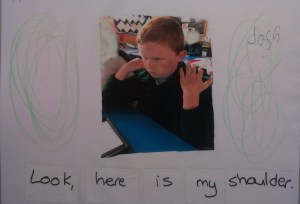
All the better if students can also be involved in the creation of their personalised books – they love to read and share books they have had a part in creating. Involving students in the creation of books encourages them to engage in the writing process, and provides many opportunities for communication, both about the content of the writing, and about the writing process itself. Having students involved in the writing of the books also helps to highlight the links between writing and reading, and reinforces understandings of important concepts about print.
Books can be made up in programs like PowerPoint or Clicker, or with a range of iPad apps (such as Pictello or BookCreator), allowing them to be accessed via a range of methods, or they can simply be made on paper. These books can easily be printed, laminated, and bound at very low cost, adding great, personalised resources to your class library. They can also be shared through the Tar Heel Reader website, for example, allowing your student(s) to truly publish their work to the world.
One method of creating personalised books with emergent readers and writers is Predictable Chart Writing. This process incorporates a range of literacy skills and concepts. It is an example of a shared writing experience – adults writing with students. Whilst the process is designed for use with a group or class, it can work for individual students as well, with a little adaptation. In fact, all the photos used here are from charts created with individual students.
Predictable Chart Writing is a five-step process (generally one step per day), giving you a week of activities with each chart. Each day’s tasks should take between 10 and 20 minutes to complete. The five steps are as follow:
- Day 1: Write the Chart
- Day 2: Reread/Work with the Chart
- Day 3: Cut-up Sentences
- Day 4: Be the Sentence
- Day 5: Make the Book
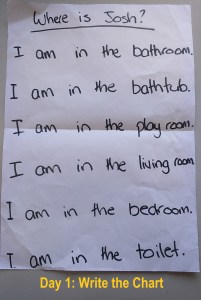 | 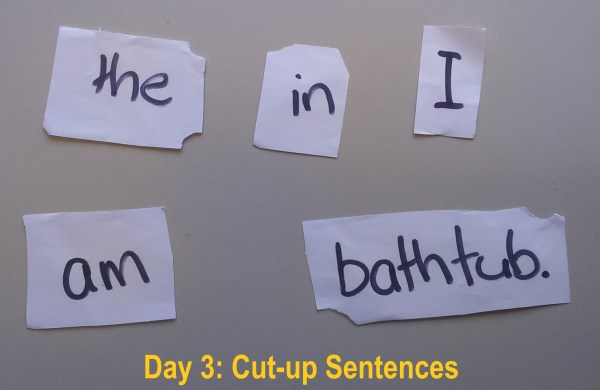 |
For further details on the tasks undertaken on each of the five days, see this document: PCW – Five Day Process.
Predictable charts also allow those students, who are physically able to, the opportunity to illustrate their books. For students who are loathe to ‘make a mark’ this can be a great way to give them the opportunity to develop an understanding of how they can get their ideas across by ‘making marks’. Look at the progress in the ‘drawing’ of this student, in the space of a few short weeks.
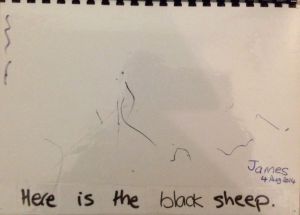 | 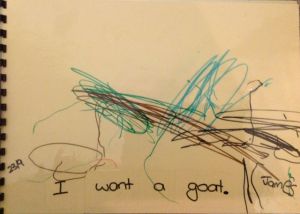 |
Initially James would barely hold a writing implement and made only the faintest of marks. Two months later, he was gripping the implement strongly, putting much more weight through it, and happily adding multiple layers to his drawings.
Look also at the progress made by Josh in his drawing between July 2016 and July 2017 – from simple scribble, to the beginnings of pictures.
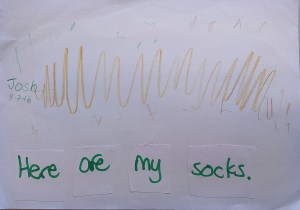 | 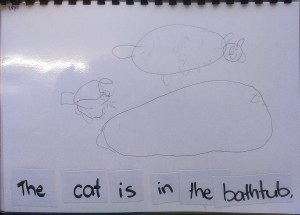 |
Once it is complete, be sure to share your book with others, and do not forget to put it in the student or class library (or browsing box) for self-selected reading time. Alternatively, you could keep it in the ‘online’ bookshelf on the iPad.
Predictable charts can be adapted to a variety of levels. Check out this blog post about a predictable chart sequence completed by an older group of students working on a unit about healthy eating.
One of my own students created this Tar Heel Reader book as part of a Predictable Chart Writing sequence when we were working on colours.
If you would like to find out more about Predictable Chart Writing, you might like to look at this Online Self-Directed Module from the Dynamic Learning Maps Professional Development series. This module is provided by the Center for Literacy and Disability Studies, University of North Carolina at Chapel Hill.
This book provides an overview of the process and plenty of ideas for sentence starters.
To see the 5 day predictable chart process in action with some students with complex needs (with some adaptations to meet the needs of the specific students), check out these videos from the “We Speak PODD” YouTube Channel. This family uses PODD for communication with all their children. The videos show some of the predictable chart activities and how PODD is used to support those: Day 1 – Day 2 – Day 3 – Day 4 & Day 5
To download the October Tip of the Month, click here.
Created by Helen Brunner (Teacher/Trainer) on 23/08/17.
Emergent Literacy
Predictable Chart Writing – writing WITH students.
Engaging some students in reading and writing can be difficult. Linking to students’ personal experiences and personalising books to individual students, or groups of students, can assist with motivation to read. By incorporating pictures and text that relate directly to students, their interests and experiences, and to the people, things, and places that are familiar and important to them, we can get them started on the reading journey.

All the better if students can also be involved in the creation of their personalised books – they love to read and share books they have had a part in creating. Involving students in the creation of books encourages them to engage in the writing process, and provides many opportunities for communication, both about the content of the writing, and about the writing process itself. Having students involved in the writing of the books also helps to highlight the links between writing and reading, and reinforces understandings of important concepts about print.
Books can be made up in programs like PowerPoint or Clicker, or with a range of iPad apps (such as Pictello or BookCreator), allowing them to be accessed via a range of methods, or they can simply be made on paper. These books can easily be printed, laminated, and bound at very low cost, adding great, personalised resources to your class library. They can also be shared through the Tar Heel Reader website, for example, allowing your student(s) to truly publish their work to the world.
One method of creating personalised books with emergent readers and writers is Predictable Chart Writing. This process incorporates a range of literacy skills and concepts. It is an example of a shared writing experience – adults writing with students. Whilst the process is designed for use with a group or class, it can work for individual students as well, with a little adaptation. In fact, all the photos used here are from charts created with individual students.
Predictable Chart Writing is a five-step process (generally one step per day), giving you a week of activities with each chart. Each day’s tasks should take between 10 and 20 minutes to complete. The five steps are as follow:
- Day 1: Write the Chart
- Day 2: Reread/Work with the Chart
- Day 3: Cut-up Sentences
- Day 4: Be the Sentence
- Day 5: Make the Book
 |  |
For further details on the tasks undertaken on each of the five days, see this document: PCW – Five Day Process.
Predictable charts also allow those students, who are physically able to, the opportunity to illustrate their books. For students who are loathe to ‘make a mark’ this can be a great way to give them the opportunity to develop an understanding of how they can get their ideas across by ‘making marks’. Look at the progress in the ‘drawing’ of this student, in the space of a few short weeks.
 |  |
Initially James would barely hold a writing implement and made only the faintest of marks. Two months later, he was gripping the implement strongly, putting much more weight through it, and happily adding multiple layers to his drawings.
Look also at the progress made by Josh in his drawing between July 2016 and July 2017 – from simple scribble, to the beginnings of pictures.
 |  |
Once it is complete, be sure to share your book with others, and do not forget to put it in the student or class library (or browsing box) for self-selected reading time. Alternatively, you could keep it in the ‘online’ bookshelf on the iPad.
Predictable charts can be adapted to a variety of levels. Check out this blog post about a predictable chart sequence completed by an older group of students working on a unit about healthy eating.
One of my own students created this Tar Heel Reader book as part of a Predictable Chart Writing sequence when we were working on colours.
If you would like to find out more about Predictable Chart Writing, you might like to look at this Online Self-Directed Module from the Dynamic Learning Maps Professional Development series. This module is provided by the Center for Literacy and Disability Studies, University of North Carolina at Chapel Hill.
This book provides an overview of the process and plenty of ideas for sentence starters.
To see the 5 day predictable chart process in action with some students with complex needs (with some adaptations to meet the needs of the specific students), check out these videos from the “We Speak PODD” YouTube Channel. This family uses PODD for communication with all their children. The videos show some of the predictable chart activities and how PODD is used to support those: Day 1 – Day 2 – Day 3 – Day 4 & Day 5
To download the October Tip of the Month, click here.
Created by Helen Brunner (Teacher/Trainer) on 23/08/17.
